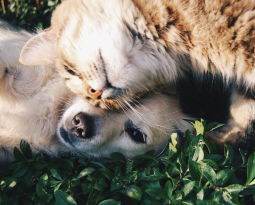If you have been following us this month then you know we are spending April talking about pests, their effects on our pets, and how to prevent them. This time we are talking about the previously mentioned hot spots. Hot spots, or moist dermatitis, are one of those injuries that can follow something like flea or tick bites. If your dog has a raw looking wet spot on them, read on, this will tell you what you need to know to get them some medical attention until their next vet visit.
Hot Spots
What Causes Hot Spots
Hot spots are caused when a dog scratches, itches, or licks themselves excessively. The constant irritation will cause a wet scab area on the fur, the moisture of which can allow for a bacterial infection to begin. It doesn’t take much moisture for the infection to take hold either! Something as simple as a walk-in rain can be enough.
Fortunately, almost all hot spot bacteria respond to antibiotics, both topical and oral.
How to Treat Hot Spots
First, you will want to trim the area surrounding the hot spot, using basic hair clippers. If the area is large, shaving it can help greatly as the increased airflow will help speed up the drying process, allowing for healing to accelerate.
After trimming the surrounding hair, clean the area with a mild antiseptic spray, specialized shampoo, or astringent. Make sure these are water-based, and then pat dry.
Next, apply hydrocortisone cream or spray to the wound. This will require a veterinarian’s prescription, but the product will help stop the itching which got your pet here in the first place. When the wound is no longer being itched nonstop, it can truly start to heal.
Despite the hydrocortisone, your pet may still try to lick at the wound. It’s their natural way of tending to their injuries and so we need to provide a little extra support to stop that behavior. Using an Elizabethan collar (the dreaded Cone of Shame) can prevent them from over licking.
Keep an eye on your pet and the hot spot. While the decreased agitation, cleaning, and medicine should all start the healing process, sometimes the infections are just too severe and will need a vet visit with stronger antibiotics or other treatment.
Note: Hot spots can be incredibly painful. If your pet isn’t allowing you to do what needs to be done, then you need to take them into the vet and let a professional treat the injury. This isn’t something you want to leave alone as the infection can spread and spread causing serious complications.
Hot spots are no joke, without any sort of treatment they can spread or develop fast! Make sure to keep your dog well groomed, as any dirty hair or matted coat creates a greater risk for developing the sores. While they are also called summer sores, hot spots can develop at other times of the year, so don’t think you can ignore this potential problem 3/4ths of the time.
If your dog has a hot spot and needs professional treatment, give us a call, and we can get them on the path to healing quickly!







